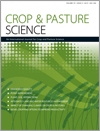Soil test–wheat (Triticum aestivum L.) grain yield response relationships to lime application were defined using soil pH (pHCaCl2) and aluminium extracted (AlCaCl2) by 0.01 m calcium chloride. Soil AlCaCl2 at 10–20 or 10–30 cm, or the average, maximum or weighted concentration at 0–30 cm provided a more accurate definition of the response relationship (r2 0.69–0.74) than soil pHCaCl2 (r2 0.27–0.29 for soil layers 20–30 and 10–30 cm). For wheat grown in the south of Western Australia, the critical value (defined at relative yield = 90% of maximum) for soil AlCaCl2 ranged between 2.9 and 4.5 mg Al kg–1, depending on sampling depth.

Crop and Pasture Science
Volume 70 Number 4 2019
The study of the mechanism of cytoplasmic male sterility is of great significance for accelerating the utilisation of heterosis. This study identified several genes related to MU-type sterile lines. It will provide a theoretical basis for an in-depth understanding of the mechanism of male sterility and its application in production practice.
CP18116Crop responses to subsoil manuring. II. Comparing surface and subsoil manuring in north-eastern Victoria from 2011 to 2012
A 2-year field experiment on a Chromosol soil with a dense clay subsoil compared the effectiveness of surface and subsoil manuring, using applications of 20 t poultry litter ha–1. Both surface and subsoil manuring increased wheat yields in 2011, but only subsoil manuring increased yields in 2012, when there was limited spring rainfall, suggesting that subsoil manuring is more effective in the second year after treatment in years with a dry finish.
CP18216Adaptation of field pea varieties to organic farming across different environments of Italy
The choice of appropriate varieties is a great challenge when growing organic field pea. We assessed the effect of temporal and spatial variation of abiotic and biotic stresses on variety responses, defined the adaptation patterns of recent varieties across climatically contrasting environments of Italy, and highlighted useful plant characters under organic farming. The results suggest that selecting widely adapted varieties by multi-year evaluation in climatically contrasting sites can be an efficient strategy for field pea breeding targeting organic farming in Italy.
CP18350Precise nitrogen topdressing upregulates nitrogen metabolism and improves soybean (Glycine max) grain yield

By up-regulated soybean nitrogen metabolism, topdressing at 40 DAE and 90 DAE increased soybean grain yield significantly. With topdressing at beginning seed stage (90 DAE), the higher yielding cultivar had a higher nitrate metabolism capacity at the late reproductive stages.
CP18324Genotypic differences in phosphorus acquisition efficiency and root performance of cotton (Gossypium hirsutum) under low-phosphorus stress
 , Qinghui Wang, Heike Bücking, Jiandong Sheng, Jia Luo, Zhongping Chai, Arjun Kafle, Yinying Hou and Gu Feng
, Qinghui Wang, Heike Bücking, Jiandong Sheng, Jia Luo, Zhongping Chai, Arjun Kafle, Yinying Hou and Gu Feng
Significant genotypic variation in P-acquisition efficiency (PAE) was existed among the cotton genotypes. P-efficient genotypes demonstrated great tolerance to P deficiency. Root morphology, especially surface fine root length and middle root length, played an important role in P uptake under P-limited conditions.
Xuzi6 had high tolerance to iron deficiency and better effect on improving re-greening. Foliar application of Fe2(SO4)3 had better effect on remission of iron-deficient symptoms of sweet potatoes. Leaf SPAD values of xuzi6 under treatment of Fe2(SO4)3 were higher than FeSO4 after five days of fertilisation. Iron concentrations in applied leaves of xuzi6 varied similarly between FeSO4 and Fe2(SO4)3, which increased steadily over time and its highest value was about four time as higher as that of xuzi8.
Awnless barnyard grass seeds germinated at alternating day/night temperatures ranging from 20/10°C to 35/25°C. Seedling emergence was highest on the soil surface, decreased with increased burial depth, but no seedlings emerged from 8 cm. Emergence reduced by 47% with the sorghum residue load of 8 t ha–1.
CP18274Effects of continuous nitrogen application on seed yield, yield components and nitrogen-use efficiency of Leymus chinensis in two different saline-sodic soils of Northeast China
Effects of nitrogen (N) application on seed yields and yield components in Leymus chinensis were measured in a field experiment with two saline-sodic soils. Application of N improved seed yield, mainly through increased spike number and heading percentage; however, significant annual differences in seed yield occurred in the two soils. Application of N significantly impacted N efficiencies, and high soil pH and electrical conductivity adversely affected seed yield and N-use efficiency.
CP18403Physiological characteristics and forage accumulation of grazed Marandu palisade grass (Brachiaria brizantha) growing in monoculture and in silvopasture with Eucalyptus urograndis
Adoption of a proper designed and managed silvopasture is required to sustain pasture productivity. Our objective was to compare agronomic and physiological characteristics of a silvopasture, in the Brazilian Amazon biome. Marandu palisade grass can tolerate PAR reduction in silvopasture up to ~20% without reduction in forage accumulation; however, physiological modifications (maintenance leaf photosynthesis, increase specific leaf area and chlorophyll indexes) occurred to support its potential use in agroforestry systems.



